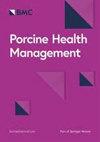Biosecurity measures for the prevention of African swine fever on German pig farms: comparison of farmers’ own appraisals and external veterinary experts’ evaluations
IF 3.1
2区 农林科学
Q1 VETERINARY SCIENCES
引用次数: 0
Abstract
Since its first introduction into the German wild boar population in 2020, African swine fever (ASF) has been spreading slowly from the eastern border westwards and has been introduced into eight domestic pig farms thus far. The European Food Safety Authority has named deficits in farm biosecurity and increased human activity as major risk factors for the introduction of the ASF virus into pig farms. Studies have shown that pig farms in Germany generally have a high level of biosecurity. However, veterinary practitioners and policy-makers have expressed concerns that not all pig farmers are appropriately prepared to deal with the threat of ASF. This study aimed to evaluate the level of biosecurity on pig farms in Lower Saxony and explore the reasons for deficits in the implementation of biosecurity measures. For this purpose, pig farmers were interviewed in open structured face-to-face interviews about their perception of ASF and biosecurity, and the implemented measures on their farms were assessed with a checklist. In the data analysis, the farmers’ answers and the results of the biosecurity check were compared to gain further insights into the factors influencing the implementation of biosecurity measures on the farms. The biosecurity check showed that on most farms, a high level of biosecurity had been implemented. Nevertheless, deficits were found concerning the fences and the delimitation of clean and dirty areas on farm grounds and in the anteroom. Overall, the farmers were well informed about ASF and had a realistic perception of their own biosecurity. They considered the farm layout, financial means and practicality of hygiene measures to be the main barriers to implementing biosecurity measures against ASF. However, the results also suggested that farmers’ attitudes and legal regulations were major influencing factors. The results indicated a high level of biosecurity against ASF on most pig farms and a realistic perception of their own biosecurity by the farmers. Current knowledge transfer and information should focus on building upon the farmers’ own motivation and expertise and supporting them to put existing knowledge into practice.德国养猪场预防非洲猪瘟的生物安全措施:农民自己的评价与外部兽医专家的评价比较
非洲猪瘟(ASF)自 2020 年首次传入德国野猪种群以来,一直从东部边境向西缓慢传播,迄今已传入八个国内养猪场。欧洲食品安全局指出,农场生物安全的不足和人类活动的增加是导致非洲猪瘟病毒传入养猪场的主要风险因素。研究表明,德国养猪场的生物安全水平普遍较高。然而,兽医从业人员和政策制定者表示担心,并非所有养猪场都做好了应对 ASF 威胁的充分准备。本研究旨在评估下萨克森州养猪场的生物安全水平,并探讨生物安全措施执行不力的原因。为此,通过开放式结构的面对面访谈,了解养猪场主对 ASF 和生物安全的看法,并使用核对表对养猪场实施的措施进行评估。在数据分析中,对养殖户的回答和生物安全检查的结果进行了比较,以进一步了解影响猪场实施生物安全措施的因素。生物安全检查结果显示,大多数农场实施了高水平的生物安全措施。不过,在围栏以及农场地面和前厅的清洁区和脏污区划分方面仍存在不足。总体而言,养殖户对 ASF 有充分的了解,并对自身的生物安全有切实的认识。他们认为,农场布局、财力和卫生措施的实用性是实施抗 ASF 生物安全措施的主要障碍。不过,调查结果表明,农民的态度和法律法规也是主要影响因素。结果表明,大多数养猪场的防疫生物安全水平较高,养殖户对自身生物安全的认识符合实际情况。当前的知识转让和信息传播应侧重于提高农民自身的积极性和专业知识,并支持他们将现有知识付诸实践。
本文章由计算机程序翻译,如有差异,请以英文原文为准。
求助全文
约1分钟内获得全文
求助全文
来源期刊

Porcine Health Management
Veterinary-Food Animals
CiteScore
5.40
自引率
5.90%
发文量
49
审稿时长
14 weeks
期刊介绍:
Porcine Health Management (PHM) is an open access peer-reviewed journal that aims to publish relevant, novel and revised information regarding all aspects of swine health medicine and production.
 求助内容:
求助内容: 应助结果提醒方式:
应助结果提醒方式:


